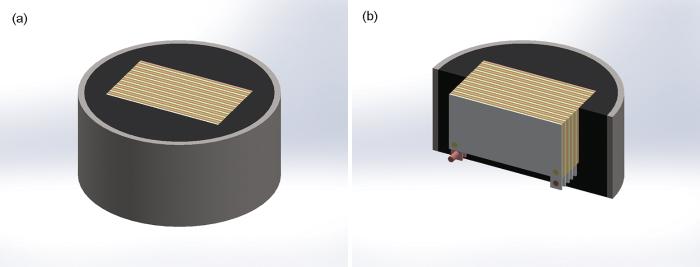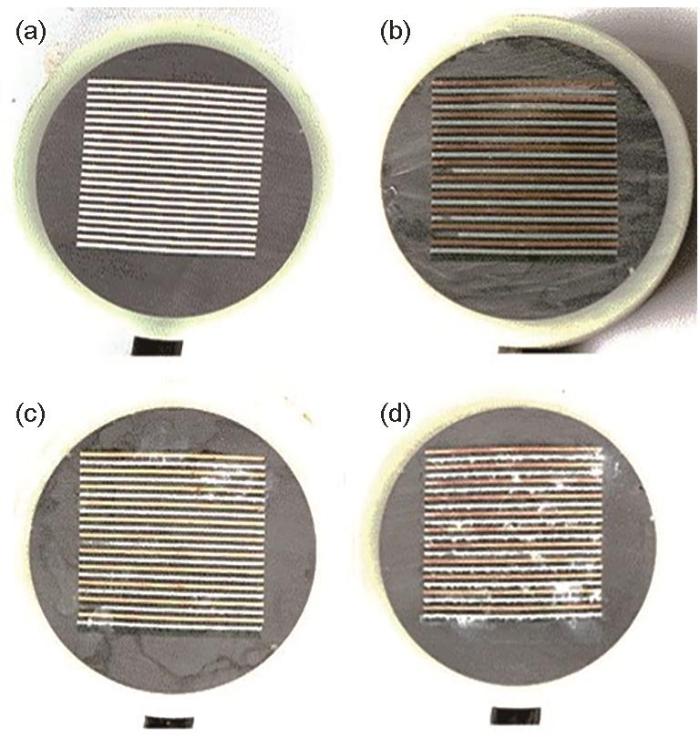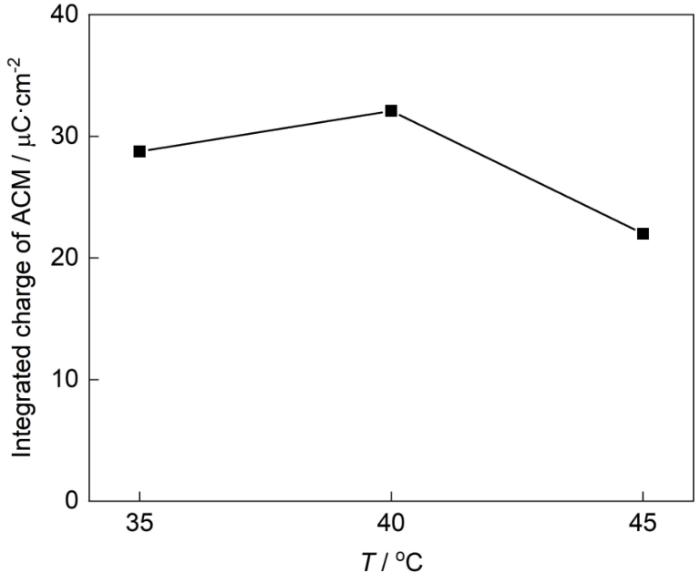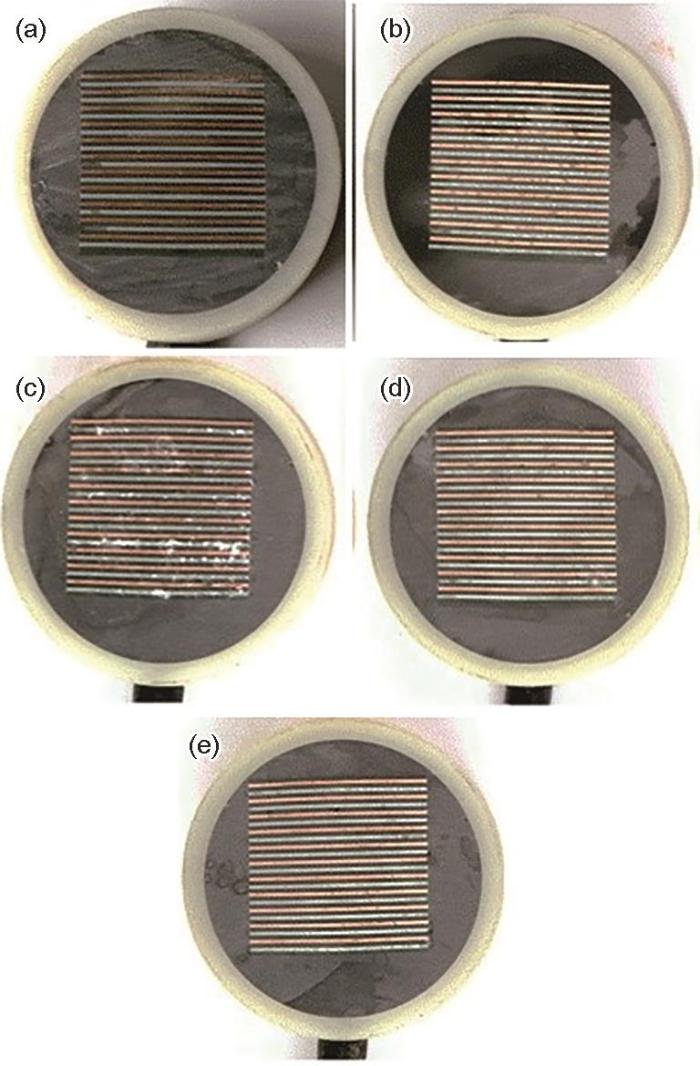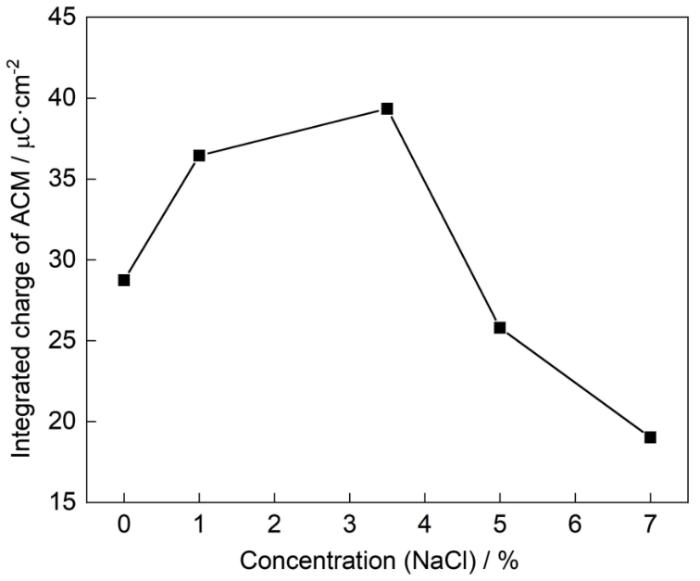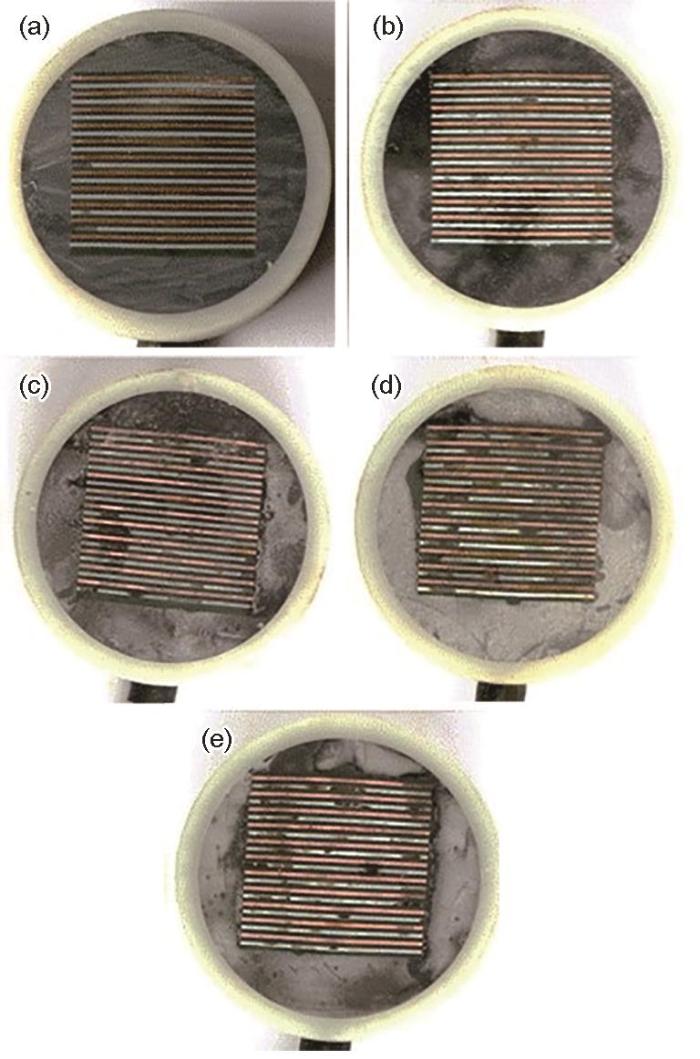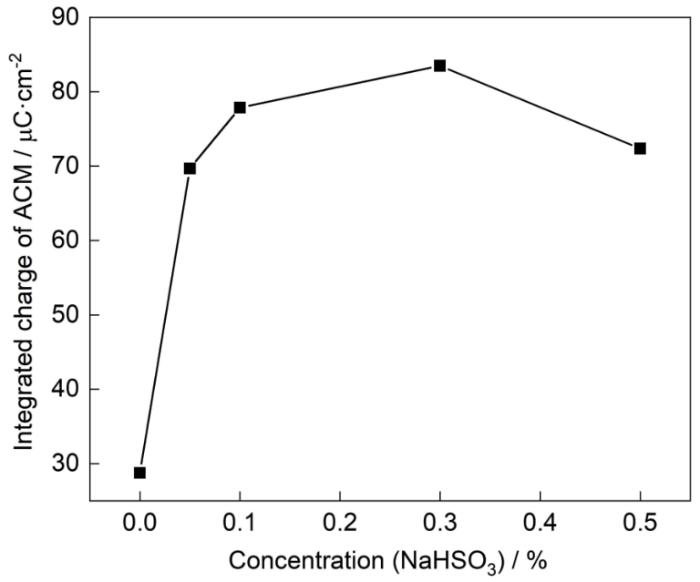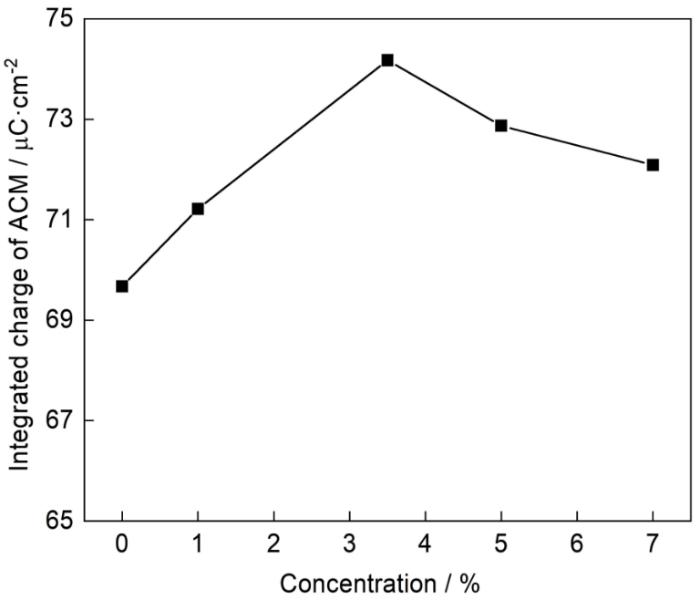金属材料的腐蚀普遍存在于自然环境和工业环境,给人类带来了巨大的经济损失和危害 [1]。由于Zn具有低的腐蚀电位和腐蚀速率,其成为钢铁腐蚀防护的理想材料[2]。大气腐蚀监测(ACM)技术是基于薄液膜下的电化学腐蚀测试原理,应用于金属大气腐蚀行为研究具有很好的优势[3~5]。在用大气腐蚀监测的电化学方法替代传统重量法的研究方面国外的学者做出了大量的研究,而国内在这方面研究还不太深入[6~8]。日本学者较多使用Fe-Ag或者Fe-Zn电偶组成ACM探头用于汽车车身腐蚀监测[9],然而从研究结果不难看出Fe-Ag电偶探头使用寿命存在问题,且Fe-Ag或者Fe-Zn电偶探头难以预测车身镀锌钢部分的腐蚀状况。因Zn相比于Fe具有更大的电位差,监测敏感性更强,为了探寻钢铁表面镀锌层的腐蚀行为,引入Cu-Zn电偶并研究获取不同温度以及盐浓度对Cu-Zn电偶的影响,为Cu-Zn电偶监测提供依据。
Li等[10]和Pei等[11, 12]提出腐蚀大数据概念,并采用ACM传感器对中国6个室外动态大气环境中碳钢在一个月内的初始大气腐蚀进行了研究。基于收集到的约250000个腐蚀数据集,研究了相对湿度、温度和降雨量对碳钢初始腐蚀行为的环境影响。Wang等[13]对比了NaHSO3+NaCl混合溶液中和野外暴晒时Zn及LY2铝合金的腐蚀过程,认为两者的结果能较好地吻合,因此NaHSO3+NaCl混合溶液是理想的大气腐蚀模拟溶液。Huang等[14]对Fe-Zn ACM传感器进行改造,利用室内试验和现场试验揭示了温湿度对ACM输出数据的影响。Shinohara等[15]开发了一种由Fe-Ag电偶组成的ACM型腐蚀传感器,可区分和确定环境中降雨、凝露和干燥,并通过经验校准曲线估计沉积的海盐量。Cao等[16]采用ACM电化学方法研究了环境参数对碳钢大气腐蚀的影响,研究表明SO2会大大加速碳钢的腐蚀,SO2的重要性与其浓度和相对湿度密切相关。Wang等[17]采用石墨锌耦合型ACM传感器研究了山东省多地区户外环境以及实验室环境因素对Zn腐蚀影响,研究表明温度和相对湿度会影响Zn的腐蚀速率,并且存在耦合温度和相对湿度对腐蚀速率的影响。
本文拟采用紫铜、纯锌两种材料制备ACM大气腐蚀探头,通过盐雾模拟试验分别探究不同温度、不同NaCl溶液浓度、不同NaHSO3溶液浓度以及NaCl和NaHSO3混合浓度条件对ACM腐蚀探头积分电量的影响。通过ACM技术在线获得大气环境中材料的腐蚀情况信息,可以为产品设计和研制、质量评价、材料和工艺筛选及其整体环境防护决策提供依据。
1 实验方法
本研究所使用的实验材料为紫铜、纯锌。以纯锌材料作为ACM腐蚀探头的阳极,紫铜材料作为ACM腐蚀探头的阴极,阴极与阳极之间使用0.3 mm的绝缘材料隔开。使用线切割工具将紫铜和纯锌材料进行切割,尺寸为20 mm×10 mm×0.3 mm,依次采用400、600、800和1000#的水磨砂纸对试样表面打磨,用丙酮和无水乙醇对试样进行清洗,将试样冷风干燥后按照“阳极(纯锌)-绝缘材料-阴极(紫铜)”顺序排列,相同电极试片与铜导线进行焊接连接,使用环氧树脂胶对其进行封装(如图1所示)。对封装后的腐蚀探头依次采用400、600、800和1000#的水磨砂纸将试样表面打磨。
图 1
图 1
ACM腐蚀探头示意图
Fig. 1
Schematic diagram of ACM corrosion probe: (a) comprehensive diagram, (b) half section view
采用Q-Fog盐雾试验箱进行盐雾试验,将ACM腐蚀探头悬挂于盐雾箱中的固定位置,设置盐雾箱为持续喷雾模式、湿度RH = 100%,试验周期为24 h。用ACM仪实时记录ACM电流值,通过下式对时间求腐蚀电流的积分值,并将其转换为ACM积分电量。Cu-Zn腐蚀探头的积分电量为:
其中,
以纯水为盐雾试验试剂,设置盐雾箱温度梯度为35、40和45℃,以研究Cu-Zn腐蚀探头对温度的敏感性以及环境温度对ACM积分电量的影响。
温度对Cu-Zn腐蚀探头存在影响,为了将温度对探头的影响降低到最小,决定采用试验温度梯度的最小温度,即35℃条件,研究盐浓度对Cu-Zn腐蚀探头的影响。设置盐雾箱内NaCl溶液浓度(质量分数,下同)梯度为0、1.0%、3.5%、5.0%、7.0%,以研究Cu-Zn腐蚀探头对Cl-的敏感性以及Cl-浓度对ACM积分电量的影响。设置盐雾箱内NaHSO3溶液浓度梯度为0、0.05%、0.10%、0.30%、0.50%,以研究Cu-Zn腐蚀探头对HSO
2 结果与讨论
2.1 温度对ACM积分腐蚀电量的影响
图2
图2
Cu-Zn腐蚀探头宏观形貌
Fig.2
Macro morphologies of Cu-Zn corrosion probe: (a) blank group, (b) 35 ℃, (c) 40 ℃, (d) 45 ℃
Cu-Zn腐蚀探头的积分电量随温度的变化如图 3所示。对于Cu-Zn探头,温度从35℃升高到40℃时,其ACM积分电量也相应升高,但当温度为45℃时,由于腐蚀速率较快,探头表面积聚了大面积的白色絮状腐蚀产物,这些产物附着在探头表面上。在盐雾试验条件下,这些产物的一部分仍在持续腐蚀,导致探头表面部分被覆盖。在这种情况下,可以明显观察到腐蚀反应分为两个主要部分:首先,涉及Cu-Zn电偶的腐蚀反应;其次,直接在ACM探头上腐蚀产物部分发生的腐蚀反应。因此,在45℃的温度下,Cu-Zn探头的腐蚀表面受到了明显影响,积分电量相对较小。
图3
图3
Cu-Zn探头的ACM积分电量随温度的变化关系
Fig.3
Relationship between ACM integrated charge of Cu-Zn probe and temperature
2.2 NaCl浓度对ACM积分腐蚀电量的影响
图4
图4
不同NaCl浓度盐雾试验Cu-Zn腐蚀探头的宏观形貌
Fig.4
Macro morphologies of Cu-Zn corrosion probe in salt spray tests with different NaCl concentrations: (a) 0, (b) 1.0%, (c) 3.5%, (d) 5.0%, (e) 7.0%
Cu-Zn腐蚀探头的积分电量随NaCl浓度的变化如图5所示。Cu-Zn探头对NaCl的浓度变化较为敏感。对于Cu-Zn探头,其积分电量随NaCl浓度变化波动明显,其积分电量曲线变化趋势呈现出先升高后降低,变化趋势与腐蚀产物覆盖率的变化趋势相同,表明腐蚀反应目前以Cu-Zn电偶腐蚀反应为主。当NaCl浓度为3.5%时,出现最大积分电量,表明Cu-Zn探头对浓度为3.5%的NaCl气氛具有较高的敏感性。
图5
图5
Cu-Zn腐蚀探头的ACM积分电量随NaCl浓度的变化趋势
Fig.5
Variation trend of ACM integrated charge of Cu-Zn corrosion probe with NaCl concentration
2.3 NaHSO3 浓度对ACM积分腐蚀电量的影响
Cu-Zn两种ACM探头在NaHSO3浓度分别为0、0.05%、0.10%、0.30%、0.50%的环境下放置24 h后的宏观形貌如图6所示,ACM探头腐蚀产物覆盖率为3.87%、4.61%、10.51%、12.61%、19.92%。Cu-Zn腐蚀探头对NaHSO3的浓度变化非常敏感,随着NaHSO3浓度的升高,探头表面的锈蚀程度加剧,这是因为电极材料Cu本身对含S的环境非常敏感,容易发生腐蚀,加之NaHSO3的电离,试验气氛呈酸性,更加剧探头的锈蚀。对于Cu-Zn探头,由于NaHSO3小液滴的凝聚,在电极上出现了黑色或灰色的条带状的腐蚀区域,局部腐蚀严重。
图6
图6
不同NaHSO3浓度盐雾试验Cu-Zn腐蚀探头的宏观形貌
Fig.6
Macro morphologies of Cu-Zn corrosion probe in salt spray tests with different NaHSO3 concentrations: (a) 0, (b) 0.05%, (c) 0.10%, (d) 0.30%, (e) 0.50%
Cu-Zn两种ACM探头的积分电量随NaHSO3浓度的变化如图7所示。
图7
图7
Cu-Zn腐蚀探头的ACM积分电量随NaHSO3浓度的变化关系
Fig.7
Relationship between ACM integrated charge of Cu-Zn corrosion probe and concentration of NaHSO3
Cu-Zn探头对NaHSO3的浓度变化都很敏感。当NaHSO3的浓度≤0.30%时,Cu-Zn腐蚀探头的积分电量随着NaHSO3浓度的增加而增加,与腐蚀产物覆盖率相关性较好;当NaHSO3的浓度在0.30%~0.50%时,由于电极对NaHSO3的酸性环境很敏感,探头锈蚀严重,在探头表面形成的锈层,锈层产物通常被认为时ZnSO4、ZnO以及少量的ZnHSO3[17],阻隔介质进一步侵入电极,所以锈层的产生对探头起到一定的保护作用。同理,腐蚀反应分为Cu-Zn电偶腐蚀和腐蚀产物进一步反应,当NaHSO3的浓度为0.30%~0.50%时,Cu-Zn腐蚀探头表面腐蚀产物覆盖率增加,而积分电量随着NaHSO3浓度的增加反而降低。
2.4 NaCl和NaHSO3 混合浓度对积分腐蚀电量的影响
在控制NaHSO3浓度为0.05%不变的前提下,调节NaCl浓度分别为0、1.0%、3.5%、5.0%、7.0%的环境中放置24 h后的宏观形貌如图8所示,ACM探头腐蚀产物覆盖率为4.61%、7.24%、40.61%、76.74%、79.40%。Cu-Zn腐蚀探头对于NaHSO3和NaCl的混合体系浓度变化非常敏感,锈蚀十分严重。对于Cu-Zn探头,在较低的NaCl浓度时,探头表面有局部的棕黄色锈蚀斑出现,数量较少分布不均,在较高的NaCl浓度时,探头表面的锈层呈灰黑色,Cu电极的红色区域已不可见。
图8
图8
NaHSO3浓度为0.05%,不同NaCl浓度盐雾试验Cu-Zn腐蚀探头的宏观形貌
Fig.8
Macro morphologies of Cu-Zn corrosion probe in salt spray tests with NaHSO3 concentration of 0.05% and NaCl concentration of 0 (a), 1.0% (b), 3.5% (c), 5.0% (d) and 7.0% (e)
Cu-Zn腐蚀探头的积分电量随混合浓度的变化如图9所示。Cu-Zn探头的ACM积分电量对混合浓度变化敏感。在NaHSO3浓度为0.05%的条件下,随着NaCl浓度的增加,探头的积分电量虽略有起伏,但是波动范围不大。
图9
图9
Cu-Zn腐蚀探头的ACM积分电量随混合浓度的变化关系
Fig.9
Relationship between ACM integrated charge of Cu-Zn corrosion probe and variation of mixed concentration
在NaCl浓度较低时,并且由于HSO
可见在混合体系中,NaHSO3和NaCl起到协同作用。在NaHSO3浓度为0.05%时,当NaCl浓度为3.5%时,Cu-Zn腐蚀探头的积分电量达到最大值。
3 结论
(1) Cu-Zn探头的积分电量在35~40℃可以较好的反映温度的变化,在40~45℃受腐蚀产物保护层的影响,不能较好反映温度变化趋势。
(2) NaCl浓度由0逐步增大7.0%时,Cu-Zn探头的积分电量整体呈先增加后减小的趋势,在NaCl浓度为3.5%时,积分电量最大。
(3) NaHSO3浓度由0逐步增大0.50%时,Cu-Zn探头的积分电量呈现先增加后降低趋势,在NaHSO3浓度为0.30%时,积分电量最大。
(4) NaHSO3浓度为0.05%时,当NaCl浓度由0逐步增大7.0%时,Cu-Zn探头的积分电量呈现先增加后降低,在NaCl浓度为3.5%时,积分电量最大。
(5) Cu-Zn探头对温度、NaCl浓度、NaHSO3浓度以及二者混合体系浓度的变化敏感,有较高的灵敏度,综合考虑各因素Cu-Zn探头的腐蚀影响为:温度<NaCl浓度<NaHSO3浓度<NaCl和NaHSO3混合浓度。
参考文献
China corrosion investigation report
[J].
中国腐蚀调查报告
[J].
Development trend of hot-dip galvanizing technology
[J].
热镀锌技术的最新进展
[J].
Progress in experimental methods for atmospheric corrosion of metals
[J].
金属大气腐蚀实验技术进展
[J].
Sixteen-year atmospheric corrosion exposure study of steels
[J].
碳钢、低合金钢16年大气暴露腐蚀研究
[J].

获得了17种钢在我国7个试验点的16年大气暴露腐蚀试验数据,试验点的环境包括了亚热带、温带、工业性、海洋性,干燥环境及湿热环境等各种典型环境。钢的大气腐蚀的发展遵循幂函数规律:D=Atn;其中D为腐蚀深度(mm),t为暴露时间(年),A、n为常数。短期暴露所显示的大气腐蚀规律与长期暴露所显示的不同,可靠的大气腐蚀参数只能来自长期暴露。对碳钢和低合金钢,危害最大的污染是SO2及氯离子。SO2在开始一、二年危害作用很突出,但在以后作用明显下降。对非耐候钢,湿热条件对长期腐蚀的影响非常大,如果加上污染,会造成特别高的腐蚀。
Study on the effects of air pollution on corrosion of carbon steel
[J].
大气污染对碳钢的腐蚀影响研究
[J].
Reviews on investigation networks for atomspheric corrosion and suggestions on coming development
[J].
我国大气腐蚀网站试验研究回顾及发展建议
[J].
Estimation of the corrosion losses by the acidic Rain in China
[J].
中国的酸雨对材料腐蚀的经济损失估算
[J].

阐述了酸雨的形成和定义,酸雨在中国的分布与危害.根据传 统的经验方法和Uhlig方法保守的估计了中国酸雨在1999年对材料的直接经济损失大约30亿 元.间接损失要远高于这个数字.
Monitoring technology for automobile corrosive environments
[J].
Materials science: share corrosion data
[J].
Towards understanding and prediction of atmospheric corrosion of an Fe/Cu corrosion sensor via machine learning
[J].
Understanding environmental impacts on initial atmospheric corrosion based on corrosion monitoring sensors
[J].Atmospheric corrosion monitoring (ACM) sensors were employed to study the initial atmospheric corrosion of carbon steels over a one-month period in six outdoor dynamic atmospheric environments in China. Based on the ~250,000 corrosion data sets collected, the environmental impacts of relative humidity, temperature and rainfall on the initial corrosion behavior of carbon steels were investigated. The results showed that rainfall was the strongest environmental factor influencing the initial atmospheric corrosion rate. Relative humidity significantly influenced the corrosion of carbon steels in low-precipitation environments and non-rainfall period.
Corrosion behavior on aluminum alloy LY12 in simulated atmospheric corrosion process
[J].
Field study of weather conditions affecting atmospheric corrosion by an automobile-carried atmospheric corrosion monitor sensor
[J].
Evaluation of corrosivity in atmospheric environment by ACM (atmospheric corrosion monitor) type corrosion sensor
[J].
Electrochemical investigation on atmospheric corrosion of carbon steel under different environmental parameters
[J].
Influence of temperature and relative humidity on the atmospheric corrosion of zinc in field exposures and laboratory environments by atmospheric corrosion monitor
[J].
Long-term atmospheric corrosion of zinc
[J].
Corrosion kinetics and patina evolution of galvanized steel in a simulated coastal-industrial atmosphere
[J].The corrosion kinetics and patina (corrosion products) layer evolution of galvanized steel submitted to wet/dry cyclic corrosion test in a simulated coastal-industrial atmosphere was investigated. The results show that zinc coating has a greater corrosion rate during the initial period and a lower corrosion rate during the subsequent period, and the patina composition and structure can greatly affect the corrosion kinetics evolution of zinc coating. Moreover, Zn5(OH)6(CO3)2 and Zn4(OH)6SO4 are identified as the main stable composition and exhibit an increasing relative amount; while Zn12(OH)15Cl3(SO4)3 cannot stably exist and diminish in the patina layer as the corrosion develops.
Initial corrosion behavior of pure zinc in simulated tropical marine atmosphere
[J].
Synergistic effect of NaCl and SO2 on the initial atmospheric corrosion of Zinc under wet-dry cyclic conditions
[J].




